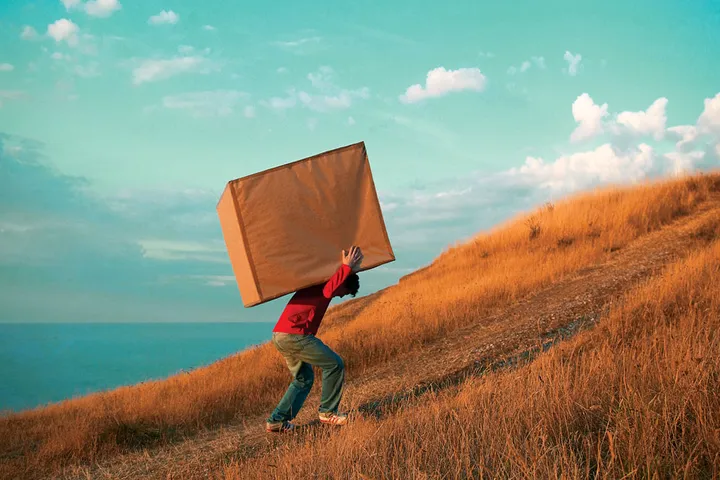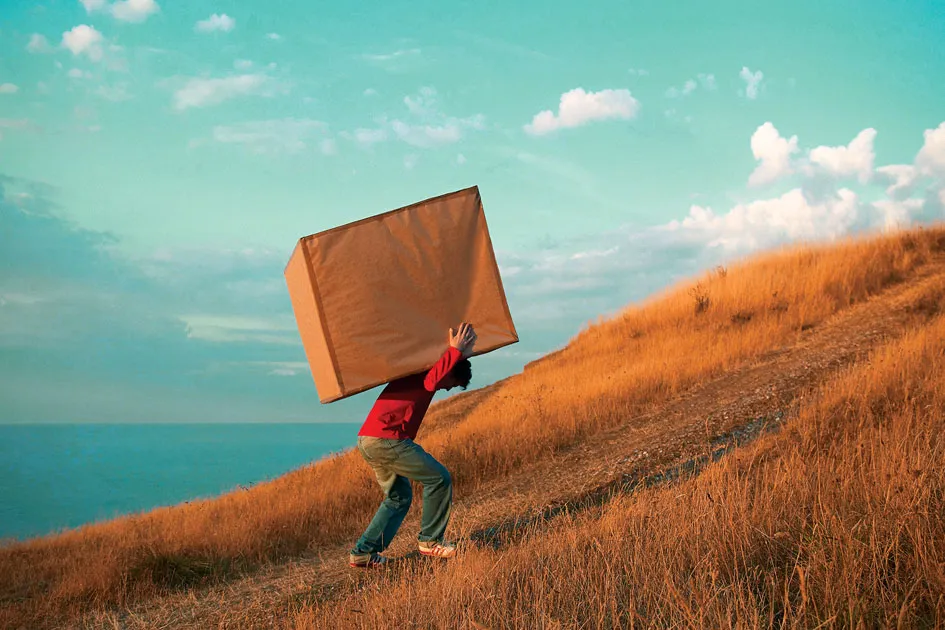Jerry Gibree watched his left hand with both bewilderment and intense concentration. He was trying out a state-of-the-art prosthesis that translates muscle impulses into movement, but it wasn’t exactly instinctive. Thinking clench opened the mechanical fingers; open made the wrist twirl. This would take some re-education.
Adjusting to a new hand and leg promised to be challenging, but Jerry welcomed the opportunity to regain a measure of self-sufficiency. At 66, the war vet had lived his life undaunted and self-reliant—an embodiment, of sorts, of his native Rhode Island’s iconic statue, the Independent Man. Until the accident.
A text message from the leader of our home group interrupted that peaceful Wednesday afternoon: Pray quick for Jerry. He has been hurt and 911 on the way. More when I know.
A very long short time later, a second message arrived: Marge just called sobbing. Sounds very serious. Maybe a crushing injury to leg and/or hand?? All I could understand was she didn’t know if he was going to make it.
Then a third: Went to OR at 3:40. Keep praying his leg and hand can be saved.
In storms that tore through Atlanta on June 13, 2013, straight-line winds had toppled a dozen trees and hung up several more at the Gibree home in suburban Roswell. Damage in the area was so extensive that tree services were booking three weeks out. Waiting, however, wasn’t an option—since their daughter’s family shared the property, leaving the yard in precarious condition was too dangerous for the children.

And, as it turns out, for Gibree himself. Though the retired fireman had extensive experience in construction (which included dismantling their Tennessee
pre-Civil War log home and rebuilding it in Georgia), removal of the stricken trees proved unpredictable—and just a hair shy of fatal.
Because the house was undamaged, Jerry initially considered cleanup no big deal. He spent the morning of the 19th clearing the yard, and when his wife Marge and their daughter Kerrin called him for lunch, he declined, preferring to complete the final area. But after the women returned to a project in the basement, the suspended tree Gibree was working on dropped and rebounded.
He didn’t see it but heard his leg snap like a dry pine branch. Then, as the tree went by, it caught his wrist and peeled his hand back.
The basement was out of earshot, but Kerrin’s husband Bill had been delayed in leaving for work. Perceiving repeated staccato cries of “Help! . . . Help!” he ran out to discover his father-in-law’s dire predicament. Despite profuse bleeding, Jerry somehow never lost consciousness, and the paramedic training that had saved others’ lives now helped save his own. He sent Bill to fetch Kerrin and leather belts—and explained how to slow blood loss with tourniquets and elevation of the wound. Maneuvering the smashed leg up onto the fallen tree was a gruesome task for Gibree’s daughter, but it kept her father alive till rescue workers reached the scene.
Jerry stayed conscious all the way to the trauma center, where son Seth met the entourage. The last thing his father told him before being taken to the O.R. was, “I think I’m dying.” That was an accurate read on the situation: Gibree flatlined three times during the 10-hour operation. But thanks to a skilled team of four surgeons—hand, orthopedic, vascular, and trauma—plus 38 units of blood, he survived day one, still in possession of his crushed limbs.
He remained in critical condition and was kept in a drug-induced coma for 10 days. During that time, doctors found it necessary to remove his left hand; the following week it was decided his leg wasn’t salvageable, either. With surgery taking place on July 4th, Independence Day acquired new meaning for the family.
Those of us who knew him well had trouble imagining what life would be like for Jerry, who was always wielding either a home-improvement tool or spot-on—and sometimes gruff—sense of humor.
“You know, none of this is bad. If this is what God has for me now, I’m fine with it.”
Not many days after the amputations, I asked him how he dealt with waking up to such changes. Jerry lifted what remained of his arm and said, “You know, none of this is bad. If this is what God has for me now, I’m fine with it.” Seeing the turn of events as the Lord’s plan, he was sure God had good purposes in mind.
Marge likewise faced the tragedy with trust. Already one with a solid routine of quiet time and Christian music, she doubled down on devotions and prayer, which kept her moored during those turbulent days of progress and setbacks. “Every morning through the whole thing,” she said, “I would either hear a song or read something in Scripture that set me for the day.”
For friends and family, it was impossible to witness the Gibrees’ acceptance of their situation without wondering how we would respond to such life-altering circumstances. And the couple’s faith, which encouraged and challenged our own, was about to get a wider audience.
Technology—and a Megaphone
Kerrin and Seth started a CaringBridge website so that after her quiet time, Marge could summarize Jerry’s status and whatever message of hope was keeping her afloat that day. Not only did the family receive powerful support through readers’ replies, but journaling also confirmed what Passion City Church’s Louie Giglio teaches—that when Christians stay focused on the cross, their suffering becomes a “megaphone of hope” to the world. Logging more than 16,000 visits, the blog elicited over 30 pages of guestbook replies; many bore out the loudspeaker idea, like the note by a new believer who gained a sense of peace from witnessing Jerry’s faith in action. “Such an amazing thing to put all control into God’s hands,” she wrote. “Just hearing what faith can do in the most frightening, horrific circumstances has strengthened my [own].”
“I can see God weaving a tapestry of our lives. We have a long battle ahead, but with God, all things are possible.”
Marge’s journaling ministered near and far, as her words connected with people via prayer lists at churches around the country. The correspondence was overwhelming. Day after day, she received replies testifying to how God was using her family’s circumstances to impact not just friends and relatives but also strangers she’d otherwise never meet. The messages frequently mentioned being inspired by the Gibrees’ attitude, thanking them for sharing the beauty of their life in the midst of pain. One person wrote, “It MEANS something to know [that], like the heroes in the Bible, you can stand strong in faith, yet weak as a human. It means those ‘stories’ are not just stories, but the truth. It solidifies my faith in Jesus and allows me to accept my walk with just a little more humility.”
Blogging also gave Marge an opportunity to piece together how God had been working over 50 years to prepare them for this time. Three weeks after the accident, she wrote about a pattern coming into focus. First, her lifelong friendship with Jeanne Marie Campbell—a young neighbor left quadriplegic by polio—made Marge comfortable and knowledgeable about caring for someone with disabilities. Next, Jerry expected to make a career of air traffic control, the work he’d learned in the military, but was forced to take time off after returning from Vietnam with hepatitis. When a fireman academy opened nearby, he changed direction and instead became a paramedic. Then in 2003, 11 years after moving their log home to Roswell, Jerry built an adjacent garage, which he converted in 2009 to a dwelling designed for the needs of old age. When the Gibrees moved in, Kerrin and her family took over the big house. “I can see God weaving a tapestry of our lives,” Marge wrote. “We have a long battle ahead, but with God, all things are possible.”
Making Strides; Losing Ground
The battle, in fact, was about to intensify. In October, a fungal infection—likely contracted from the tree’s bark—showed up in Jerry’s left femur. Besides halting progress with his prostheses, this development also necessitated three-hour I.V. treatments 78 days straight. Not only were the side effects uncomfortable and enervating, but the relentless infection ultimately caused three further “revisions” of the amputation, rendering the artificial leg unusable.
Despite this protracted setback, Jerry was accepting of the additional surgeries, having undergone at least 20 orthopedic operations prior to the accident. “I’ve got a lot of spare parts, that’s for sure,” he said, itemizing a plate in his neck, fused vertebrae, and a knee replacement, ironically in what is now his remaining leg.

“What’s your most difficult challenge?” I once asked him. “The hardest thing is always the next thing,” he said. “Right now, it’s trying to get comfortable with the [leg] prosthesis. They constantly have to tweak something—I call it ‘a thousand little adjustments.’”
But then he reconsidered. “Something tough? My pride.” He’d never viewed that as one of his failings, because he wasn’t a boastful person. The accident, however, made him realize pride takes many forms. Jerry was always glad to do things for others. “But boy,” he said, “I have trouble accepting help.”
With the ever-present twinkle in his eye, he chalked it up to being from Rhode Island. But perhaps there’s more truth than Jerry realizes to identifying with its famous statue. The smallest state has a rich spiritual history. Roger Williams—the original inspiration for the Independent Man—established Providence as a refuge for freedom of worship. With “Hope” as the state’s motto and the anchor its symbol (see Hebrews 6:19), Rhode Island’s heritage suggests the real value of independence: the freedom to live with properly placed dependence.
The ordeal brought that into focus for Jerry, so he has crafted a mission statement for his ongoing recuperation: “May I not become a victim of my seeming improvement or progress.” Because he fears falling into Israel’s pattern of drifting from God in times of self-sufficiency, he is able to say, “The accident may be the best thing that ever happened to me.”
Read the prayer that helped Jerry Gibree get through his darkest hours here.
Photography by Andrew Thomas Lee





